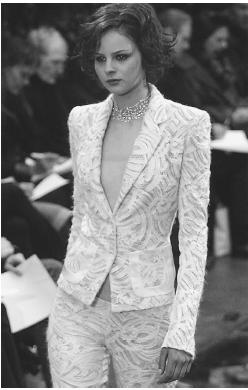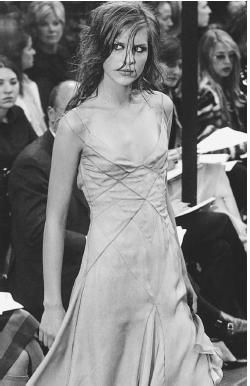Richard Tyler - Fashion Designer Encyclopedia
Australian designer working in Los Angeles
Born: Sunshine, Australia, circa 1948, son of a factory foreman and a seamstress. Family: Married Doris Taylor (divorced); married Lisa Trafficante, 1989; children: Sheriden, Edward. Career: Opened store, Zippity-doo-dah, in Melbourne, Australia, late 1960s; designed outfits for rock stars, early 1970s; designed and traveled with Rod Stewart's Blondes Have More Fun tour, 1978; started the Richard Tyler collection with wife and partner, Lisa Trafficante, late 1980s; opened Los Angeles showroom, Tyler Trafficante, 1988; opened New York City showroom, 1992; named head designer for Anne Klein & Company, 1993; left Anne Klein & Company, 1994; reintroduced menswear line, 1995; hired as designer for Byblos, 1996-98; initiated bridal line, 1999. Awards: Council of Fashion Designers of America (CFDA) New Talent award, 1993; CFDA Womenswear Designer of the Year, 1994; Designer of the Year Award (CFDA), 1996; Gumleaf award by Australian American Chamber of Commerce (contribution to Australian and American Culture), 2001.
Publications
On TYLER:
Books
Stegemeyer, Anne, Who's Who in Fashion, Third Edition, New York, 1996.
Articles
Beckette, Kathleen, "Runway Report: My One and Only Hue— Richard Tyler," in the New York Post, 4 November 1994.
"New York: Richard Tyler," in WWD, 4 November 1994.

Schiro, Anne-Marie, "The V-Shaped Jacket of the 1940s Makes a U-Turn," in the New York Times, 5 November 1994.
Spindler, Amy M., "Anne Klein's Designer Departs," in the New York Times, 20 December 1994.
Campbell, Roy H., "Richard Tyler Takes the High Fashion Moments with the Lows," in Knight-Ridder/Tribune News Service, 2 February 1995.
LaFerla, Ruth, "Richard Tyler, Perfectionist," in Elle (New York),>March 1995.
"New York: Richard Tyler," in WWD, 5 April 1995.
Spindler, Amy M., "Oldham and Tyler Look Super," in the New York Times, 6 April 1995.
Anniss, Elisa, "Richard Courts," in Footwear News, 29 July 1996.
Conti, Samatha, "Behind the Purge at Byblos," in DNR, 4 December 1996.
Sanchez, Eurydice, "Richard Tyler Exclusive Interview," in Men Mode Magazine, Spring 1997.
"Richard Tyler," in Current Biography, May 1997.
Ginsberg, Merle, "Golden Moments in Fashion," in WWD, 8 January 2001.
Young, Kristin, "Tyler Receives Gumleaf Award," in WWD, 1 February 2001.
Haber, Holly, "Too, Too Tyler," in WWD, 3 March 2001.
Rubenstein, Hal, "The Look of Richard Tyler," in In Style, 1 July 2001.
Townsend, Catherine, "Bridal Collection 2002, Brides Who Rock," available online at www.fashionwindows.com , 8 August 2001.
Various articles and reviews in GQ, October 1990; Harper's Bazaar, October 1992; New York, 12 October 1992; Vogue, August 1993; New York, 13 September 1993; People, 21 February 1994; Newsweek, 4 April 1994; New York, 11 April 1994; and Vogue, October 1994.
***
"At my age, I'm thrilled," 46-year-old Richard Tyler told People magazine when he won the Council of Fashion Designers of America New Talent award in 1993. Just one year later, he walked away with the Council's Womenswear Designer of the Year award—one of the fashion world's highest honors. Although Tyler's fame may have come later in life than other designers, it quickly grew, earning him the respect of his peers and the devotion of his customers.
Much of Tyler's initial success was due to his celebrity clients. Julia Roberts, Janet Jackson, Sigourney Weaver, and Oprah Winfrey are just a few of the stars who have publicly praised the exemplary quality and fit of his clothes. "That's the age-old recipe for success in fashion: get the right people to wear your clothes," Patrick McCarthy, the executive editor of Women's Wear Daily, told Newsweek. Although his famous clients might have drawn new customers in, Tyler's attention to detail and fine tailoring have kept his business growing. Everything on a Richard Tyler design is done by hand. Identical and precise buttonholes are a hallmark of his collection, and his fabrics— the finest wools, silks, and linens—boast such details as individual stripes sewn onto the cloth with silk threads.
Tyler was born in Sunshine, Australia, just outside Melbourne. His mother was a costumer with the Melbourne Ballet and sewed wedding dresses, men's suits, and clerical robes as well. Tyler's father was a plastics factory foreman with one of the best wardrobes in town. It was through his mother that Tyler learned his love for fine quality tailoring. At age 16, Tyler dropped out of school and began work as a tailor at a shop known for outfitting the Australian prime minister. He also spent some time at a factory, cutting out bras. At the age of 18, with his mother's help, Tyler opened his own store, Zippity-doo-dah, in a rundown section of Melbourne. His father paid the bills and his mother sewed his designs in the back room.
By the 1970s, Tyler's shop was beginning to attract a steady clientéle. Australian celebrities, and such touring musicians as Cher, Elton John, and Alice Cooper, began to seek out his Lycra and sequined outfits. During this time, Tyler married Doris Taylor. The marriage lasted 10 years, and they had a son, Sheriden, born in the late 1970s. After Tyler's mother died in 1976, he made many trips to London, continuing to dress a growing cadre of musicians.
In 1978 Rod Stewart asked Tyler to design his Blondes Have More Fun tour. When the show stopped in Los Angeles, Tyler fell in love with the city and decided to make it his home. He continued to design for performers, including Supertramp, the Bee Gees, the Go-Gos, and Diana Ross. But as costume demands became increasingly outrageous in the mid-1980s, Tyler began to drop his work for the stars. He stayed in Los Angeles, doing odd jobs and trading his gardening and sewing skills for rent at the guest houses of friends.

Tyler then spent two years in Oslo, Norway, but ended up back in Los Angeles in 1987, with his last $100 and a plane ticket home to Australia. The night before he was to fly home, he met Lisa Trafficante, an actress and businesswoman, who would change his life forever. Together, Tyler and Trafficante formed a partnership enabling them to establish the Richard Tyler line of clothing. Trafficante urged Tyler to follow his strengths and design finely-tailored menswear. She took it upon herself to come up with a business plan and the necessary capital.
Tyler's clothes were so bold that many buyers thought their customers wouldn't buy them. It was during their last appointment of the day, at the boutique If in SoHo, that Tyler and Trafficante received their first order. If's customers were immediately drawn to Tyler's work, and within two years Chativari in New York City and Wilkes Bashford in San Francisco were also buying from Tyler. In 1988 Trafficante persuaded Tyler that they needed to open their own showroom in Los Angeles. With the backing of Trafficante's sister Michelle and investor Gordon DeVol, they bought a drapery manufacturing building in an out-of-the-way part of town. They gutted the interior of the art deco building and created a bare, contemporary setting for Tyler's fashion-forward designs.
The store was named Tyler Trafficante, and it was there that Tyler first became known for his trademark fitted jackets. Diana Rico, writing for GQ, described the transformation felt after trying on a Tyler jacket: "Its dashing cut and construction are so comfortable that you feel as though you're barely wearing anything at all. The sensuous silk lining and luxurious hand-tailored details bespeak an old-world emphasis on fine craftsmanship, while the stagy lapels, offbeat colors and elongated silhouette give the piece a daring rock and roll edge." Although the showroom started without a women's section, so many women came in off the street requesting clothes that the next season Tyler began designing for them.
It was the demand for women's clothes that really sparked the growth of Tyler Trafficante. Within five years, they had one of the hottest stores in Los Angeles. In 1992 Tyler decided it was time to introduce his line to New York. The New York fashion world welcomed him and the press lauded his debut show in March of 1993. The reviews were barely in when he was contacted by the upscale women's sportswear line Anne Klein & Company, asking him to sign on as their new design director. Many in the fashion world questioned the pairing of Tyler—known for his bold, sexy designs—with Klein, a label manufacturing traditional, conservative career clothes for women. The first year Tyler began designing for Anne Klein, store orders rose 30 percent. Despite the immediate jump in sales, the reviews of the Anne Klein line were mixed.
In December of 1994, Anne Klein and Tyler parted company. There were a number of problems that plagued his tenure with Anne Klein. Tyler had difficulty controlling quality and price: his demand for impeccable quality raised the price of an Anne Klein jacket by 15 percent. In addition, he was not used to overseeing a huge staff of pattern makers, tailors, design assistants, and dressmakers. Many speculated that the overriding reason for Tyler's termination, however, was that in his attempt to attract a younger customer, he made too many changes too soon and turned off Klein's traditional customers.
Industry insiders had no doubt, however, of Tyler's rebound. He left Anne Klein with a reported $2.1 million buyout of his contract. In the near future, Tyler planned to launch a secondary line, with a lower price point so that more women can afford his clothes. In 1995, Tyler relaunched his men's line. "The timing was right for coming back to menswear. I felt that at this point we could fill a niche that has opened up. I also think men are tired of wearing big baggy clothing—a look I personally hate," Tyler told Mode Magazine in the spring of 1997.
In 1996 Donatella Girombelli hired Tyler as the chief designer at Byblos, the famous Italian label. He was hired for the job because, according to Girombelli, he was both a designer and a craftsman. He produced four women's collections and two men's collections for Byblos while at the same time producing similar lines in America under his own name. Also in 1996, he joined forces with Rossimoda, a shoe manufacturer based in Italy. Tyler creates sketches with his staff and then sends them to Rossimoda for prototypes to be made. The shoes match his womenswear collections and sometimes inspire his collections because they are produced first.
Tyler was replaced at Byblos by John Bartlett in 1998 and returned to his Tyler Trafficante home base. His lines include Richard Tyler Couture, a designer sportswear line, and the most recently added Richard Tyler Bride in 1999. The bridal debut line featured quilted embroidery with handmade roses, which has become his signature on his bridal gowns. Tyler remains a choice designer for Hollywood celebrities to wear to various functions, including award shows. His clothes are well received, fashion-forward, and wearable. He describes his business as a life investment, and although he thrives on challenges, he has found his place in the fashion world and is currently has no plans for further expansion.
—Molly Severson;
updated by Donna W. Reamy
Comment about this article, ask questions, or add new information about this topic: